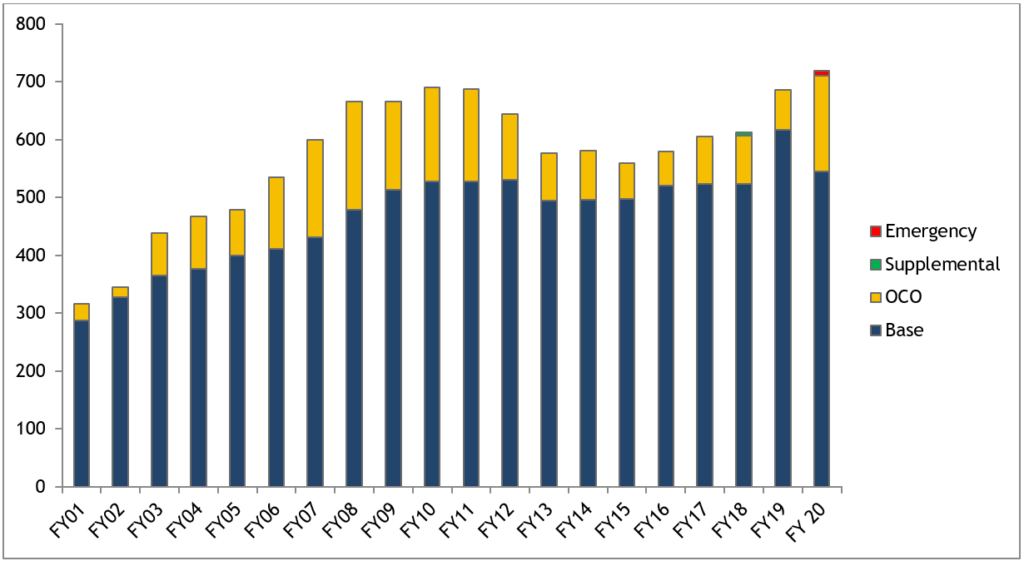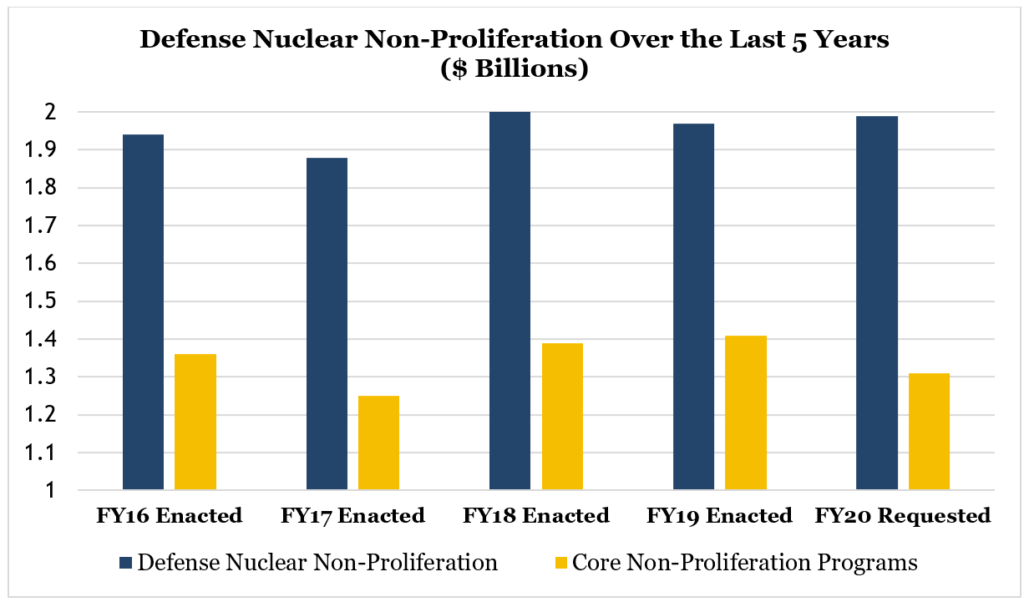The Fiscal Year 2020 Budget in Context
Introduction
President Trump’s Fiscal Year 2020 budget requests $544.5 billion for the Defense Department’s annual “base” discretionary budget, which is more than $70 billion lower than FY19 enacted levels. However, the Pentagon’s portion of the Overseas Contingency Operations (OCO) account – which is often referred to as the “war funding” account – includes $164.6 billion, an amount nearly $96 billion higher than FY19 enacted levels. The Pentagon’s own budget documents state that almost $98 billion of the OCO account is for “base budget requirements,” an implicit admission that the account is being used for more than “war funding” and to skirt budget caps imposed by Congress. In fact, Navy funding for components related to the modified W76-2 “low-yield” warhead is located in the OCO account. Another $9 billion is allocated for “emergency requirements,” which includes President Trump’s proposed border wall spending.
The Pentagon request does not include certain other security spending, including funding for nuclear weapons-related work in the Department of Energy. Including all of these accounts, the total national defense discretionary spending request is $750 billion (see the table on page 3).
Nuclear Modernization and Non-Proliferation
The request increases funding for nuclear weapons refurbishment plans, which aim to overhaul and maintain nearly the entire nuclear arsenal at a cost of approximately $1.7 trillion over 30 years, adjusted for inflation. This plan includes funding for a new long-range bomber, a new nuclear-capable cruise missile, a new ballistic missile submarine program, an updated land-based intercontinental ballistic missile (ICBM), and their associated warheads. Actualizing these plans will likely result in decreased funding for conventional military capabilities.
The budget also proposes a $60 million increase to the Defense Nuclear Nonproliferation account compared to the amount enacted in FY 2019. However, core non-proliferation programs will see a cut of $100 million. These cuts include an approximately $65 million reduction of the Global Material Security program, which works to reduce and protect vulnerable nuclear and radiological material located around the globe, and a further $80 million cut for nonproliferation research and development.
The President’s Request
Discretionary Defense Request for Fiscal Year 2020
(in billions of current dollars)
| FY 2019 Enacted: | FY 2020 Funding Request: | Allocated to: |
| 616.1 | 544.5 | Department of Defense Base Budget (051) |
| 68.8 | 164.6 | Overseas Contingency Operations (War Funding) |
| N/A | 9.2 | Emergency |
| 22.4 | 23.2 | Defense Related Activities at DOE (053)* |
| 8.6 | 8.4 | Other Defense Related Funding (054)* |
| 716.0** | 750.0** | Total National Defense Spending Request (050) |
*Data provided by the White House Office of Management and Budget
** Estimate due to rounding
Fiscal Year 2020 Overseas Contingency Operations + Emergency Budget
(in billions of current dollars)
National Defense Spending by Selected Years
*Provided by the Office of Management and Budget
| Time Period | FY Enacted: | National Defense Spending:
(in billions of FY 2012 dollars*) |
| Vietnam War Peak Spending | 1968 | 557 |
| Peak 1980’s Buildup Spending | 1989 | 570 |
| Proposed Current Spending | 2020 | 653 |
Department of Defense Topline Since FY 2001
(in billions of then-year dollars)
Fiscal Year 2020 Base + OCO Discretionary Defense Request by Function
(in billions of current dollars)
| FY 2019 Estimate: | FY 2020 Funding Request: | Allocated to: | Delta FY19-FY20 |
| 150.7 | 155.8 | Military Personnel | +5.1 |
| 278.8 | 292.7 | Operations & Maintenance | +13.9 |
| 147.3 | 143.0 | Procurement | -4.2 |
| 95.3 | 104.3 | Research and Development (RDT&E) | +9.0 |
| 11.3 | 21.1 | Construction/Family Housing | +9.8 |
| 1.7 | 1.4 | Revolving & Management Funds | -0.3 |
| 685.0 | 718.3 | Total* | +33.4 |
*Estimate due to rounding
Fiscal Year 2020 Base + OCO Discretionary Defense Request by Service
(in billions of current dollars)
| FY 2019 Estimate: | FY 2020 Funding Request: | Allocated to: | Delta FY19-FY20 |
| 178.9 | 191.4 | Army | +12.5 |
| 195.6 | 205.6 | Navy | +9.9 |
| 192.9 | 204.8 | Air Force | +11.8 |
| 117.6 | 116.6 | Defense-Wide | -0.9 |
| 685.0 | 718.3 | Total* | +33.4 |
*Estimate due to rounding
Nuclear Weapons and Non-Proliferation
Fiscal Year 2020 Request for National Nuclear Security Administration (NNSA)
(in billions of current dollars)
| FY 2019 Enacted: | FY 2020 Funding Request: | Allocated to: |
| 1.9 | 2.0 | Defense Nuclear Nonproliferation |
| 11.1 | 12.4 | Weapons Activities |
| 0.4 | 0.4 | Federal Salaries and Expenses |
| 1.8 | 1.6 | Naval Reactors |
| 15.2* | 16.5* | Total NNSA Request* |
*Estimate due to rounding
Fiscal Year 2020 Request for Defense Nuclear Nonproliferation (DNN)
(in millions of current dollars)
| FY 2019 Enacted: | FY 2020 Funding Request: | Allocated to: |
| 407.1 | 342.4 | Global Material Security |
| 293.8 | 333.5 | Material Management and Minimization |
| 220.0 | 299.0 | Nonproliferation Construction |
| 129.7 | 137.3 | Nonproliferation and Arms Control |
| 575.6 | 495.4 | Nonproliferation Research and Development |
| 319.2 | 372.1 | Nuclear Counterterrorism and Incident Response Program |
| 28.6 | 13.7 | Legacy Contractor Pensions |
| -44.0 | 0 | Adjustments |
| 1,930.0* | 1,993.4* | Total Defense Nuclear Non-Total
DNN Total* |
*Estimate due to rounding
Review of DNN Funding Over Last Five Years
| FY16 Enacted | FY17 Enacted | FY18 Enacted | FY19
Enacted |
FY20
Requested |
FY20 vs. FY19 | |
| Defense Nuclear Non-Proliferation | $1.94 billion | $1.88 billion | $2.0 billion | $1.93 billion | $1.99
billion |
+ 60 million |
| Core Non-Proliferation Programs* | $1.36 billion | $1.25 billion | $1.39 billion | $1.41 billion | $1.31
billion |
– 100 million |
*Includes Global Material Security, Material Management and Minimization, Nonproliferation and Arms Control, Nonproliferation R&D.
Review of DNN Funding over last Five Years
Request for Fiscal Year 2020 Selected Nuclear Weapons
(in millions of current dollars)
| FY 2019 Enacted: | FY 2020 Request: | Allocated to: |
| 2,279.2 | 3,003.9 | Long Range Strike Bomber* |
| 3,906.3 | 2,232.0 | Ohio Submarine Replacement Program (Columbia Class) |
| 233.8 | 108.4 | B61 Tail Kit Assembly |
| 1,119.0 | 1,200.6 | Trident II Ballistic Missile Modifications |
| 414.4 | 570.4 | Ground Based Strategic Deterrent |
| 664.9 | 712.5 | Long Range Standoff Weapon |
| 654.8 | 898.6 | W80-4 Life Extension Program |
| 48.9 | 0 | W76-1 Nuclear Life Extension Program |
| 65.0 | 10.0 | W76-2 Modification Program |
| 304.3 | 304.2 | W88 Nuclear Alteration Program |
| 53.0 | 112.0 | W87-1 Modification Program (formerly IW1) |
| 35.1 | 51.5 | B83 Stockpile Systems |
*Long range strike bomber will serve both conventional and nuclear missions
State Department and Foreign Operations
| State Department and U.S. Agency for International
Development Funding In Billions ($) |
|||
| FY 18 Actual | FY 19 Request | FY20 Request | |
| State Department/USAID | 52.4 | 39.3 | 40.0 |
| State Department – Key Department Funding
In Millions ($) |
|||
| FY 18 Actual | FY19 Request | FY20 Request | |
| Peacekeeping Operations | 538 | 291 | 291 |
| Nonproliferation, Anti-Terrorism, Demining and Related Programs (NADR) | 876 | 690 | 707 |
| Contributions for International Peacekeeping Activities | 414,524 | 1,196 | 1,136 |
| State Department – Nonproliferation, Antiterrorism, Demining and Related Programs
In Millions ($) |
|||
| FY18 Actual | FY 19 Request | FY20 Request | |
| Global Threat Reduction | 70.0 | 67.0 | 72.0 |
| IAEA Voluntary Contribution | 94.8 | 90.9 | 88.0 |
| Nonproliferation and Disarmament Fund | 30.0 | 5.0 | 5.0 |
| Terrorist Interdiction Program | 36.0 | 50.0 | 50.0 |
| CTBT International Monitoring System | 29.0 | 29.0 | 29.0 |
Funding for Selected Weapons Systems
AIRCRAFT
| System | FY19 Estimate | FY20 Request |
| F-35 Joint Strike Fighter
|
$ 11,579.7 million (93 aircraft) | $ 11,211.4 million (78 aircraft) |
| F-22 Raptor Fighter
|
$909.9 million | $819.9 million |
| F/A-18E/F Super Hornet Fighter | $2,088.6 million (24 aircraft)
|
$2,024.0 million (24 aircraft) |
| V-22 Osprey Tiltrotor Aircraft | $1,430.4 million (13 aircraft) | $1,307.5 million (10 aircraft) |
| C-130J Hercules Military Transport Aircraft | $2,594.2 million
(18 aircraft) |
$1,623.9 million (11 aircraft) |
| AH-64E Apache Helicopter | $1,463.1 million
(48 upgrades and 18 new aircraft) |
$1,003.2 million
(48 upgrades) |
| CH-47 Chinook Helicopter | $284.8 million
(7 aircraft) |
$357.9 million
(9 aircraft) |
| UH-60 Black Hawk Helicopter | $1,448.3 million
(76 aircraft) |
$1,673.4 million
(98 aircraft) |
| P-8A Poseidon Anti-Submarine Warfare (ASW) Aircraft | $2,244.6 million
(10 aircraft) |
$1,513.0 million
(6 aircraft) |
| E-2D Advanced Hawkeye Early Warning Aircraft | $1,619.1 (6 aircraft) |
$1,291.4 million
(4 aircraft) |
| KC-46A Tanker | $2,379.6 million
(15 aircraft) |
$2,304.3million
(12 aircraft) |
| F-15 Eagle Fighter
|
$1,004.3 million | $2,066.1 million (8 new aircraft) |
SHIPBUILDING
| System | FY19 Estimate | FY20 Request |
| CVN 78 “Ford” Class Nuclear Aircraft Carrier | $1,748.3 million | $2,606.7 million (1 new) |
| DDG 51 “Arleigh Burke” Destroyer | $6,224.6 million
(3 ships) |
$5,753.8 million
(3 ships) |
| SSN 774 “Virginia” Class Submarine
|
$7,428.1 million
(2 subs) |
$10,218.3 million
(3 subs) |
MISSILES/ ORDNANCE
| System | FY19 Estimate | FY20 Request |
| Advanced Medium Range Air-Air Missile (AMRAAM) | $581.5 million
(328 missiles) |
$651.2million
(389 missiles) |
| Joint Direct Attack Munition (JDAM) | $1,119.3million
(43,594 units) |
$1,148.9 million
(40,388 units) |
| Joint Air-to-Surface Standoff Missile (JASSM) | $645.3 million
(360 missiles) |
$581.9million
(430 missiles) |
| Small Diameter Bomb | $209.3 million
(5,744 units) |
$275.4 million
(7,078 units) |
| Hellfire Missiles | $484.0 million
(6,066 missiles) |
$730.8 million
(9,000 missiles) |
SELECTED BALLISTIC MISSILE DEFENSE
| System | FY19 Estimate | FY20 Request |
| Ground-Based Midcourse Defense | $1,836.9 million | $1,676.5 million |
| AEGIS BMD | $1,630.9 million | $1,720.1 million |
| THAAD | $1,463.4 million | $753.8 million |
| Patriot/PAC-3 | $487.8 million | $803.7 million |
| PAC-3/MSE Missile | $1,131.3 million
(280 MSE interceptors) |
$736.5 million
(147 MSE interceptors) |
SPACE-BASED SYSTEMS
| | FY19 Estimate | FY20 Request |
| Satellite Communications (SATCOM) Projects | $830.7 million | $1,112.7 million |
| National Security Space Launch | $2,057.6 million
(5 systems) |
$1,669.6 million
(4 systems) |
| Global Positioning System III and Projects | $1,424.9 million | $1,757.2 million |
| Space Based Overhead Persistent Infrared (OPIR) Systems | $812.1 million | $1,629.2 million |
GROUND SYSTEMS
| System | FY19 Estimate | FY20 Request |
| Abrams Tank
|
$2,652.0 million
(168 upgrades) |
$2,234.3 million
(165 upgrades) |
| Joint Light Tactical Vehicle | $1,928.3million
(5,093 units) |
$1,641.6 million
(4,090 units) |
| Amphibious Combat Vehicle | $233.6 million (30 units) | $395.3 million (56 units) |
UNSTAFFED SYSTEMS
| System | FY19 Estimate | FY20 Request |
| MQ-1B/MQ-lC Predator/Grey Eagle
|
$316.8 million
(10 units) |
$124.4 million
(6 units) |
| MQ-9 Reaper Unmanned Aerial Vehicle (UAV)
|
$741.0 million
(24 units) |
$1,024.8 million
(15 units) |





